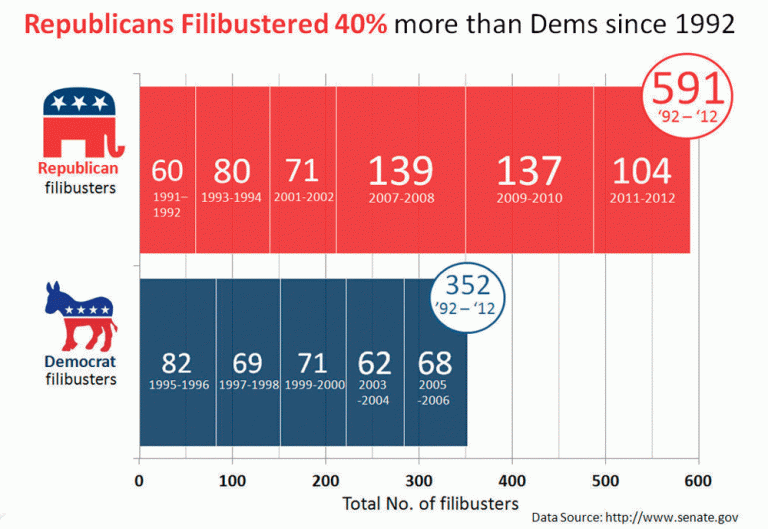
Andrew Melese
Staff Writer
In early April, the Democratic members of the U.S. Senate moved to filibuster President Donald Trump’s Supreme Court nominee, Neil Gorsuch. Gorsuch is quite conservative in his interpretation of the U.S. constitution. He refers to himself as an “originalist,” which is tantamount to being a fundamentalist when interpreting religious books such as the Bible, Quran, or Torah. In other terms, he could be reasonably described as more concerned with following the letter of the law than the intent of the law.
The Democrats were alarmed at Gorsuch’s views and moved to avoid a vote of confirmation on Mr. Gorsuch through the use of the filibuster, traditionally a method by which voting on a proposed item in the Senate or House agenda is blocked by prolonged debate or floor-speeches.
Most of the time, the filibuster is utilized through the cloture rule. Sixty votes are needed for cloture, which brings debate on a legislative issue to an end after 30 hours. Forty-one senators can thus bring a vote on an issue to a screeching halt. With the cloture rule, legislators do not even have to talk on the floor, they simply have to state their intent to filibuster. Use of the filibuster through the cloture rule is known as the silent filibuster. In this case, the vote for Neil Gorsuch, President Trump’s nominee to the U.S. Supreme Court, led Senate Democrats to attempt a silent filibuster.
However, this attempt failed because the Republicans employed what has been termed the “nuclear option,” which undermines the filibuster — allowing scheduled votes to continue despite the Democrats’ attempt by lowering the number of votes required to end filibusters on all Supreme Court nominees. In other words, when the Democrats embraced a strategy to indefinitely delay confirming Gorsuch, the Republicans responded by embracing a strategy to end the delay process itself. The filibuster was over almost as quickly as it began.
The way the Republicans allowed themselves to lower the number of votes necessary to end filibusters is through the power composition of the Senate: The Senate is structured so that the majority party has considerable power in redesigning the rules. Therefore, by changing the Senate rules, the Republican majority in the Senate — the Senate being where Supreme Court nominees are confirmed or rejected — was able to render the Democrats’ filibuster irrelevant in respect to whether Gorsuch could be blocked or not.
Democratic senators found Gorsuch sufficiently repulsive to try and block his nomination, but because the Republicans changed the very foundations of Senate procedure, the Democrats’ effort was to no avail. Because the filibuster strategy of delaying and avoiding is now essentially unable to block votes in the Senate and House of Representatives, it has lead some to believe the filibuster is an anachronistic and even worthless tool in the current political environment.
Despite the filibuster, Neil Gorsuch was confirmed as the newest member of the Supreme Court of the United States. What exactly does the filibuster now do? Does it now do anything? The answers are somewhat complicated, but generally one can say that the filibuster now has more value as symbolic opposition than as a tool of substantive obstruction against the Senate voting on Supreme Court justices.
At this point, the filibuster has no substantive ability to block voting on Supreme Court nominees. Though the number of votes required to end a filibuster against a Supreme Court vote is now only 51, 60 votes remain necessary to end a filibuster on most other issues. It is is also one mechanism by which a minority party (in this case the Democrats) can at least make clear to the public that they have galvanized against somebody or some action. It can also allow the public to learn that when the Republicans aren’t getting exactly what they want, they are undoing one of the Senate’s most historically important functions—to investigate and then confirm or reject potential Supreme Court justices as our two major parties see fit.
Though to what degree is subject to debate, the capacity to inform the country that one party is united against the other’s decision has some value. It allows the average working person to know that nearly an entire half of our two-party system finds something deeply troubling about the person Trump has selected to make decisions along with the eight other justices in our highest court.
In respect to the appointment of Supreme Court justices, the filibuster’s value now lies mostly in its ability to inform the people that an opposition party finds a nominee for our highest court unacceptable. The filibuster can also delay or kill voting on many other Senate actions where it still requires a formidable 60 votes to end one.










